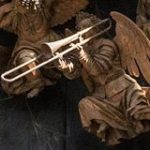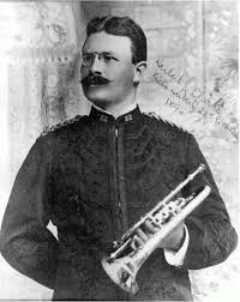Reflections on Teaching Wind Band History (for the First Time)
Matt Smith, DMA
Associate Director of Bands
University of Kansas
 Two years ago I agreed to take over our History of the Wind Band course at the University of Kansas. The course had been taught by professor James Barnes, the noted composer and former band director at the University of Kansas, who had been chair of the Music Theory and Composition department during the latter part of his tenure in our School of Music. The course is offered every other spring, and is a graduate level offering in our musicology department.
Two years ago I agreed to take over our History of the Wind Band course at the University of Kansas. The course had been taught by professor James Barnes, the noted composer and former band director at the University of Kansas, who had been chair of the Music Theory and Composition department during the latter part of his tenure in our School of Music. The course is offered every other spring, and is a graduate level offering in our musicology department.
I looked with anticipation toward teaching the course, though admittedly, my normal day-to-day responsibilities (including administering our summer camps and directing the marching band during the fall semester) limited the amount of advance preparation I was able to accomplish prior to the start of the semester. Of primary importance was to determine the texts and resources that would be used. There are a handful of books dedicated to wind band history, including major contributions by David Whitwell, Richard Hansen, Richard Franko Goldman, Frederick Fennell, and Robert Foster, as well as the online materials of Stephen Rhodes. In addition, there are a multitude of articles available through magazines and journals such as the Journal of Band Research, WASBE World, and The Instrumentalist Magazine. I opted to use an unpublished manuscript written by Professor Barnes as well as Time and the Winds by Frank Battisti.
With these resources, the course followed a linear timeline related to the development and use of instruments and ensembles beginning in the age of Antiquity. I discovered, during my preparation for the course, that some wind band history courses do not discuss the early development of wind instruments and their use in the development of western civilization. Often, the music of Gabrieli serves as the starting point for their content. It was insightful to learn about topics such as the trumpets of King Tutankhamun, and the development of ensembles in the Medieval period.
Our class met three times a week for fifty minutes per class. Assignments primarily consisted of readings that were followed by class discussions. I utilized a great number of YouTube videos to show demonstrations of instruments and various recordings. Of particular interest was the series of videos on wind band history that were produced by Sir David Whitwell. Students presented on two topics of their choice during the semester, wrote a research paper, and completed three exams, which included listening examples.
During prearranged absences I was fortunate to enlist the assistance of guest speakers, who covered topics such as American bands in the late 19th century and military bands in the United States. Professor Barnes also visited to share his personal experiences working with major figures of the last half century, including Frederick Fennell.
Looking toward the future, my own personal goal is to spend more time with the growing number of books, articles, and dissertations that are available. I would also like to examine how to best incorporate wind band history within an existing undergraduate curricula and graduate conducting seminars, as a separate course is not practical to offer in many institutions.
As my own knowledge of wind band history expanded over the semester, I realized just how significant wind instruments and the wind band was in the development of western music throughout recorded history. We take for granted the variety of functions that wind music has served, and continues to serve, be it for military services, community entertainment, music education, athletic events, and of course, the continued pursuit of the artistic potential of the ensemble. Anyone who leads ensembles of wind instruments should be educated on the rich tradition of the wind band and contributions of the leaders and composers of the wind band and its instruments, particularly as the ensemble serves these many roles.
Dr. Matthew O. Smith
Associate Director of Bands
Director, Marching Jayhawks
Director, Midwestern Music Camps
University of Kansas, Lawrence, Kansas
maosmith@ku.edu
